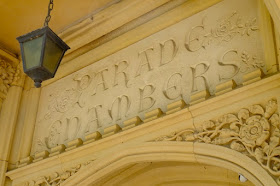Monday, May 14, 2018
Sheffield
Marks of quality
To Sheffield, where I gave a talk and spent a day or so admiring the architecture. Having little time, I restricted myself to the city centre and marvelled at the variety – of stone and brick, industrial and commercial, old and new, filigree and brutalist. One of the highlights for me were a number of architectural sculptures by the Tory family, who were active in the late-19th and early-20th centuries. First there was Frank Tory, who got his training at Lambeth College of Art before coming to Sheffield to produce carvings for the corn exchange (no longer standing). As well as doing a range of architectural carving he taught at the Sheffield College of Art and among his pupils were his twin sons Alfred Herbert and William Frank.
Here’s a bit of Frank’s work, on Parade Chambers, an 1883 building for Pawson and Brailsford, a company of printers and stationers. The architects, M E Hadfield and Sons, gave his client an impressive Tudor style building in brick with stone dressings, with offices on the upper floors, shops below. It’s a memorable building, with ornate gables, turrets, oriels, and tall chimneys, but what sets it apart for me is the carving on the stonework. The panel in my photograph is in a window above the doorway and features heads of Geoffrey Chaucer and William Caxton within wreaths of leaves.
With this panel Pawson and Brailsford put themselves firmly in the tradition of great English printers – Caxton was thought to have introduced printing to England and his first known book was an edition of Chaucer’s Canterbury Tales. This was not an unusual line for printers to take – I’ve noticed a printer doing a similar thing in Bristol. However, Edward Everard, the Bristolian printer, also linked himself with a great modern master, William Morris, and chose the latest Art Nouveau style for the decoration of his building. This Sheffield firm by contrast emphasised tradition in both architecture and decorative subject matter and their use of first-class architectural sculptors also says something about their commitment to quality.


Good! Something from "up North" - or, at least, North-ish. In the industrial heyday the Northern towns produced some impressive and interesting architecture - as I have recently discovered in Huddersfield, Bradford, etc. Also "weavers' cottages" and the like - in blackened yellow stone, with big windows touching the bottom of the roof - we need more on this sort of stuff. Perhaps you could find a similarly camera-adept deputy to do some interpretation for us north of the Trent?
ReplyDeleteAll success to this blog! It gives light relief among all the other much more serious stuff. Please keep it coming!